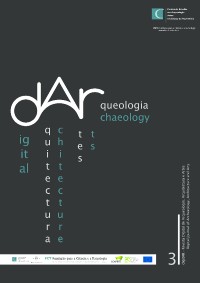Please use this identifier to cite or link to this item:
https://hdl.handle.net/10316.2/42863| DC Field | Value | Language |
|---|---|---|
| dc.contributor.author | Caldeira, B. | - |
| dc.contributor.author | Oliveira, R. J. | - |
| dc.contributor.author | Rocha, L. | - |
| dc.contributor.author | Borges, J. F. | - |
| dc.contributor.author | Neves, S. | - |
| dc.contributor.author | Fernandes, R. | - |
| dc.date.accessioned | 2017-09-22T11:30:38Z | |
| dc.date.accessioned | 2020-09-16T08:29:56Z | - |
| dc.date.available | 2017-09-22T11:30:38Z | |
| dc.date.available | 2020-09-16T08:29:56Z | - |
| dc.date.issued | 2016 | - |
| dc.identifier.issn | 2182-844X (PDF) | - |
| dc.identifier.uri | https://hdl.handle.net/10316.2/42863 | - |
| dc.description.abstract | This paper presents the results of the geophysical survey to mapping a section of the “Lapa do sono” cave, situated in Serra da Arrábida (Sesimbra), which is known to have had funerary occupation in the old Neolithic Age. Nowadays this cave finds itself widely obstructed by sediments, whose extension we intent know. Two technics frequently used in the subsurface prospection in an archaeologic environment were chosen, the Ground Penetrating Radar (GPR) and the low-frequency electromagnetic induction (EM). Due to the difficult terrain circulation state, which cannot be improved due the restrictions imposed by the nature protection defence, the data acquisition was made according an unusual paradigm. The methodology followed had based on an exhaustive analysis about a limited number of modelling profiles, using a distinct 2D processing methods. The results allow to outline the sector A of the cave inserted in a karst environment, widely fragmented, mainly on the cavity coverage areas. Evidences of other minor cavities adjacent to the main cave have also been collected; these cavities may be connected to the grotto through minor galleries filled with sediments. The interpretation of the results allowed the evaluation of the sediments thickness accumulated on the grotto surrounding’s, under the sampled profiles. | eng |
| dc.description.abstract | Neste trabalho apresentam-se os resultados da aplicação da geofísica ao mapeamento de uma secção da Lapa do Sono - Serra da Arrábida (Sesimbra), que se sabe ter tido ocupação funerária na época do Neolítico antigo e atualmente se apresenta extremamente obstruída por sedimentos. Foram escolhidas duas técnicas frequentemente utilizadas na prospecção da subsuperfície em ambiente arqueológico, o Georradar (GPR) e a Indução Eletromagnética de baixa frequência (EM). O difícil estado do terreno e os condicionalismos colocados em defesa da proteção da natureza impuseram um programa de aquisição de dados segundo um paradigma um pouco diferente do habitual. A metodologia seguida para a obtenção de resultados teve que se basear numa análise exaustiva sobre um limitado número de perfis modelados, utilizando distintas sistemáticas de processamento 2D, implementadas para despistar os principais fatores de erro. Os resultados permitem delinear a gruta principal inserida num meio cársico, extensamente fragmentado, principalmente nas áreas de cobertura da cavidade. Também se recolheram indícios de outras cavidades menores contiguas à gruta principal que podem estar a ela ligadas através de galerias menores preenchidas por sedimentos. A partir da interpretação dos resultados foi feita a avaliação da espessura de sedimentos acumuladas na periferia da gruta, sob os perfis amostrados. | por |
| dc.language.iso | por | - |
| dc.publisher | Imprensa da Universidade de Coimbra | - |
| dc.rights | open access | - |
| dc.subject | ground penetrating radar | eng |
| dc.subject | electromagnetic induction | eng |
| dc.subject | geophysical prospection in karst environment | eng |
| dc.subject | geophysics modelling. | eng |
| dc.subject | georradar | por |
| dc.subject | indução eletromagnética | por |
| dc.subject | prospeção geofísica em ambiente cársico | por |
| dc.subject | modelação geofísica | por |
| dc.title | Integração dos métodos de georradar e indução eletromagnética para o mapeamento de grutas: aplicação à lapa do sono - Arrábida | por |
| dc.title.alternative | Integration of georradar methods and electromagnetic induction for caves mapping: application to sono cave - Arrábida | eng |
| dc.type | article | - |
| uc.publication.collection | digitAR nº 3 | - |
| uc.publication.firstPage | 31 | - |
| uc.publication.issue | 3 | - |
| uc.publication.lastPage | 36 | - |
| uc.publication.location | Coimbra | - |
| uc.publication.journalTitle | digitAR: Revista Digital de Arqueologia, Arquitectura e Artes | - |
| dc.identifier.doi | 10.14195/2182-844X_3_4 | - |
| uc.publication.digCollection | IP | - |
| uc.publication.digCollection | B1 | - |
| uc.publication.orderno | 4 | - |
| uc.publication.area | Artes e Humanidades | - |
| uc.publication.manifest | https://dl.uc.pt/json/iiif/10316.2/42863/216531/manifest?manifest=/json/iiif/10316.2/42863/216531/manifest | - |
| uc.publication.thumbnail | https://dl.uc.pt/retrieve/11260859 | - |
| uc.publication.parentItemId | 71425 | - |
| uc.itemId | 71430 | - |
| uc.thumbnail.uri | https://dl.uc.pt/iiif-imgsrv/11260844/dl!3!12!40!58!124058656623784803512273206667118906193 | - |
| item.grantfulltext | open | - |
| item.fulltext | With Fulltext | - |
| Appears in Collections: | digitAR: Revista Digital de Arqueologia, Arquitectura e Artes | |
Files in This Item:
| File | Description | Size | Format | |
|---|---|---|---|---|
| integracao_dos_metodos_de_georradar_e_inducao_eletromagnetica_para_o_mapeamento_de_grutas.pdf | 1.67 MB | Adobe PDF |  |
Items in DSpace are protected by copyright, with all rights reserved, unless otherwise indicated.
